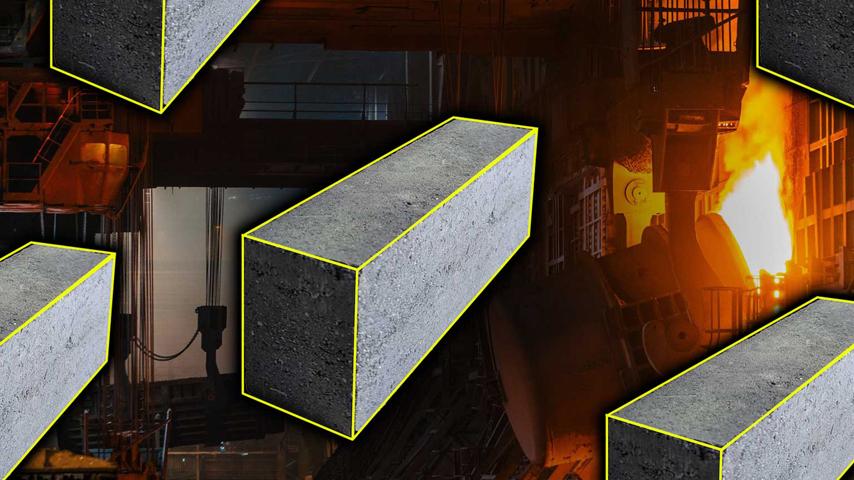Public-Private Partnership Develops New Thermal Tiles for Spaceflight
Public-Private Partnership Develops New Thermal Tiles for Spaceflight


Reusable spacecraft need to be protected from the extreme heat of reentry. A new material developed at Oak Ridge could make space launches less expensive.
Reusable spacecraft need to be protected from the extreme heat of reentry. A new material developed at Oak Ridge could make space launches less expensive.
Reusable space planes such as the Space Shuttle need to contend with thermal extremes. Temperatures in orbit are extraordinarily cold, while the heat experienced during reentry can reach as much as 7,000 °F.
Researchers at the Department of Energy’s Oak Ridge National Laboratory (ORNL), in collaboration with Sierra Space Corporation of Louisville, Colo., recently unveiled an advance in thermal protection technology. Comprising an advanced material tile face and an insulative tile backing, the silicon-carbide-based thermal protection system (TPS) is designed to withstand the intense heat and mechanical stress of repeated atmospheric re-entries, a critical factor for reusable spacecraft.
This technology will be deployed on Sierra Space’s Dream Chaser, a winged commercial spaceplane intended to transport both crew and cargo to low-Earth orbit. The company intends to begin cargo missions to the International Space Station later this year.
Developing an effective TPS is no simple task. While creating high-temperature-resistant materials is relatively straightforward, engineering them for real-world application requires deep expertise, rigorous testing, and specialized resources. The development of the material relied on the partnership between Sierra Space and ORNL. The launch services company took the lead on TPS testing and vehicle integration, leveraging NASA’s arc jet and radiant heat facilities to validate the technology’s viability. ORNL contributed its extensive knowledge in high-temperature materials.
According to Greg Larsen, the group leader for the Extreme Environment Materials Process group at ORNL, the lab has a long history in high temperature materials in harsh environments for a range of applications, from nuclear to high-speed flight. The development of the new TPS started with some existing thermal systems, including an alumina enhanced thermal barrier (AETB) base with a high temperature and oxidation resistant tile face.
“We created a high-density silicon carbide face that grade to a lower density at the AETB interface,” Larsen said. “This makes a stable aerodynamic surface, maintains good oxidation protection through the thickness, and minimizes weight. This will increase the max operating temperature of the TPS tiles and increase the number of flights that each tile can fly.”
As Larsen explained, TPS is a trade-off in cost, weight, and flight profiles, such as speed, altitude, and range. The ORNL-Sierra Space TPS is intended to be used for more flights.
Improving the number of flights per tile is critically important. “TPS tiles are expensive to make and install, so any increase in reusability drives down the cost per flight,” Larsen said.
At the same time, the tiles are similar in density to the incumbent TPS and able to withstand higher maximum operating temperatures, which will enable a broader range of flight profiles.
“Expanding the flight profile means the vehicle can re-enter the atmosphere from a broader range of orbits and fly further through the atmosphere—both down range and laterally—to land at different locations overall increasing the vehicle versatility and utility,” Larsen said. “As a comparative example, an Orion- or Apollo-style capsule, shaped as a blunt body or spherecone, has a relatively limited re-entry corridor and limited control of its flight profile while in the atmosphere. It has no wings!”
ASME Members can read more: Artemis Transcends Apollo
The conditions are so extreme and the stakes are so high that the researchers couldn’t rely only on theory when developing the TPS, said Ryan Fahsbender, an engineering fellow in advanced materials and processes with Sierra Space who was involved in the research.
“One of the primary challenges in the development of the thermal protection system was the creation of ground tests that could accurately replicate the reentry environment,” Fahsbender said. “We designed screening methods that effectively mimicked the reentry chemistry and the forces exerted on the tile faces. These methods were crucial in validating the material’s oxidative stability and structural reliability, ensuring that the thermal protection system could withstand the extreme conditions encountered during reentry.”
Jim Romeo is a technology writer in Chesapeake, Va.
Reusable space planes such as the Space Shuttle need to contend with thermal extremes. Temperatures in orbit are extraordinarily cold, while the heat experienced during reentry can reach as much as 7,000 °F.
Researchers at the Department of Energy’s Oak Ridge National Laboratory (ORNL), in collaboration with Sierra Space Corporation of Louisville, Colo., recently unveiled an advance in thermal protection technology. Comprising an advanced material tile face and an insulative tile backing, the silicon-carbide-based thermal protection system (TPS) is designed to withstand the intense heat and mechanical stress of repeated atmospheric re-entries, a critical factor for reusable spacecraft.
This technology will be deployed on Sierra Space’s Dream Chaser, a winged commercial spaceplane intended to transport both crew and cargo to low-Earth orbit. The company intends to begin cargo missions to the International Space Station later this year.
Developing an effective TPS is no simple task. While creating high-temperature-resistant materials is relatively straightforward, engineering them for real-world application requires deep expertise, rigorous testing, and specialized resources. The development of the material relied on the partnership between Sierra Space and ORNL. The launch services company took the lead on TPS testing and vehicle integration, leveraging NASA’s arc jet and radiant heat facilities to validate the technology’s viability. ORNL contributed its extensive knowledge in high-temperature materials.
According to Greg Larsen, the group leader for the Extreme Environment Materials Process group at ORNL, the lab has a long history in high temperature materials in harsh environments for a range of applications, from nuclear to high-speed flight. The development of the new TPS started with some existing thermal systems, including an alumina enhanced thermal barrier (AETB) base with a high temperature and oxidation resistant tile face.
“We created a high-density silicon carbide face that grade to a lower density at the AETB interface,” Larsen said. “This makes a stable aerodynamic surface, maintains good oxidation protection through the thickness, and minimizes weight. This will increase the max operating temperature of the TPS tiles and increase the number of flights that each tile can fly.”
As Larsen explained, TPS is a trade-off in cost, weight, and flight profiles, such as speed, altitude, and range. The ORNL-Sierra Space TPS is intended to be used for more flights.
Improving the number of flights per tile is critically important. “TPS tiles are expensive to make and install, so any increase in reusability drives down the cost per flight,” Larsen said.
At the same time, the tiles are similar in density to the incumbent TPS and able to withstand higher maximum operating temperatures, which will enable a broader range of flight profiles.
“Expanding the flight profile means the vehicle can re-enter the atmosphere from a broader range of orbits and fly further through the atmosphere—both down range and laterally—to land at different locations overall increasing the vehicle versatility and utility,” Larsen said. “As a comparative example, an Orion- or Apollo-style capsule, shaped as a blunt body or spherecone, has a relatively limited re-entry corridor and limited control of its flight profile while in the atmosphere. It has no wings!”
ASME Members can read more: Artemis Transcends Apollo
The conditions are so extreme and the stakes are so high that the researchers couldn’t rely only on theory when developing the TPS, said Ryan Fahsbender, an engineering fellow in advanced materials and processes with Sierra Space who was involved in the research.
“One of the primary challenges in the development of the thermal protection system was the creation of ground tests that could accurately replicate the reentry environment,” Fahsbender said. “We designed screening methods that effectively mimicked the reentry chemistry and the forces exerted on the tile faces. These methods were crucial in validating the material’s oxidative stability and structural reliability, ensuring that the thermal protection system could withstand the extreme conditions encountered during reentry.”
Jim Romeo is a technology writer in Chesapeake, Va.





